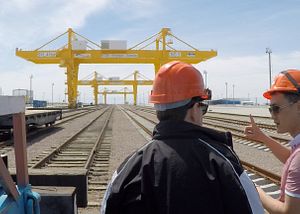By Chan Kung and Yu (Tony) Pan
 The most fundamental reason for China’s Belt and Road Initiative (BRI) lies in optimizing China’s domestic economic development model, economic structure, and industrial sector, as well as solving the historical problems left over after the rapid development of the Chinese economy from 2000 to 2010.
The most fundamental reason for China’s Belt and Road Initiative (BRI) lies in optimizing China’s domestic economic development model, economic structure, and industrial sector, as well as solving the historical problems left over after the rapid development of the Chinese economy from 2000 to 2010.
However, seven years after it was first announced, the continued advancement of the BRI is facing increasing resistance. In practice, the development of the entire initiative has deviated from the original strategic goal, as seen through two points. First, resource investment between the “Silk Road Economic Belt” (the “Belt”) and the “Maritime Silk Road” (the “Road”) is too unbalanced. In other words, the Maritime Silk Road has monopolized too many policies and material resources. Second, the implementation of the BRI overemphasizes “infrastructure connectivity.” As a result, the original grand and all-encompassing national strategy degenerated into a simple juxtaposition of “state-owned enterprises plus infrastructure.” Most importantly, the alienation of the BRI from its original goals poses huge challenges to the development prospects of the entire project.
First, the unbalanced resource distribution between the Belt and Road has caused the entire plan to lose its original geographical significance and brought unnecessary international pressure to China. A traditional land power, China is developing the Maritime Silk Road in an attempt to integrate itself into the current “sea power” system. This urge is understandable, yet such an attempt will inevitably attract anxiety and attention from the United States, the world’s largest sea power. Once the United States and Europe reach a final consensus on China’s future strategic intentions, China will likely fall into a passive situation of isolation in the international scene.
Second, the imbalance between the Belt and Road resource allocations prevents the northwest and southwest regions of China from fully participating in the BRI, which is not conducive to solving the regional development inequalities within the country. Due to the huge gap in development levels, western provinces in China must have a certain degree of policy support if they are to achieve leapfrog development, and this policy support must go beyond the previous level. However, because the overland, westward-bound “Belt” part of the BRI has not been fully developed, the impact of the BRI on these western provinces is still limited. Instead, the Maritime Silk Road, which will benefit the already-rich coastal provinces of eastern China, is being prioritized.
Third, the “state-owned enterprise plus infrastructure” model makes the entire BRI less and less sustainable at the economic level as the risk of debt continues to increase. According to OECD data, as of the second quarter of 2018, China’s non-performing assets in the BRI have reached $101.8 billion. Take Sri Lanka’s Hambantota Port as an example. Although the existence of overseas ports does have certain strategic significance, from an economic point of view it has not been a success thus far. As of the end of 2016 the cumulative losses of the port had reached $340 million, and it is still unrealistic for Hambantota Port to turn that loss into a profit in the short term. Similar cases are quite common in the current BRI.
Fourth, the current “state-owned enterprise plus infrastructure” model does not provide much substantive help to solve China’s domestic overcapacity, promote industrial upgrading, and tackle other economic legacy issues. Taking the steel industry as an example, China’s monthly steel production in June 2019 reached 87.54 million tons. In the same period, the steel output of the United States was only 7.514 million tons and that of the European Union was 13.641 million tons. It is not difficult to see that, although China has consumed some of its surplus production capacity in the construction of the BRI, this consumption is mechanical and cannot provide sufficient power for upgrading China’s industrial structure.
Comparing the initial strategic background of the BRI and its current development trend, we believe that the BRI is at a crucial point of decisive significance. China has to address this problem squarely and make appropriate policy responses in a timely manner to correct and adjust course.
Founder of Anbound Think Tank in 1993, Chan Kung is now ANBOUND Chief Researcher. Chan Kung is one of China’s renowned experts in information analysis. Most of Chan Kung’s research focuses on economic information analysis, particularly public policy.
Yu (Tony) Pan serves as the associate research fellow and the research assistant of Chen Gong. He obtained his master’s degree at George Washington University’s Elliott School of International Affairs and his bachelor’s degree from the University of International Business and Economics in Beijing.
No comments:
Post a Comment